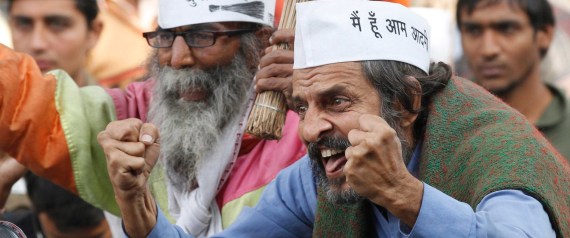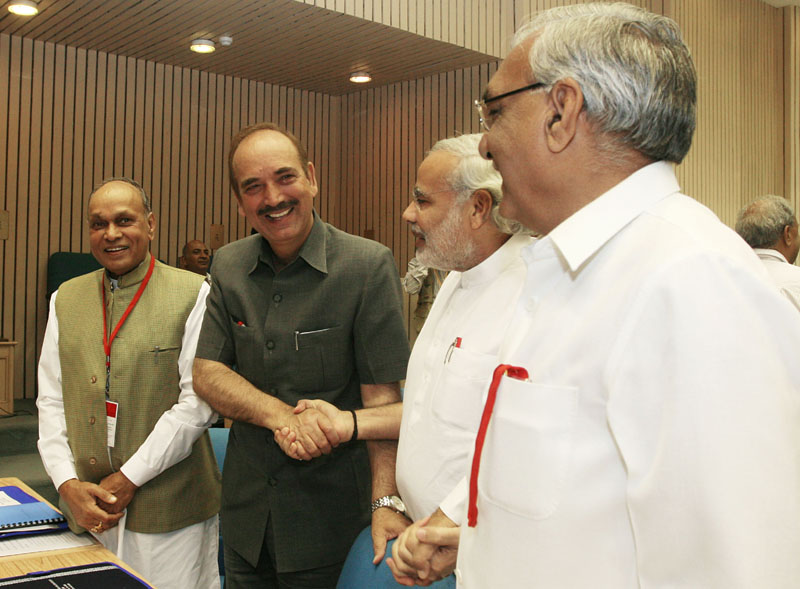The ‘Aam Aadmi’ Party [AAP] forming the Government has electrified the political atmosphere in Delhi. As it becomes the party in power in the national capital, after a short, dramatic mass election campaign, the national parties have begun to cast a wary eye on the its next move given that the Parliamentary elections are only five months away.
The two defining characteristics of ‘Aam Aadmi’ Party’s politics have made an immediate impact on the national political discourse and on the public perception about the current state of national politics: a public connect through a broader, volunteer-based party reach-out and, secondly, the humility of its leading politicians and their financial rectitude in personal and party affairs.
This is a refreshing contrast to the more “established” political parties whose leaders are seen as a class apart from the broader masses by their lifestyle and public deportment and for being the beneficiaries of state privileges derived as a class born out of mutual dependence fostered in the current era of coalition politics.
Exuding an aura of grandees and used to exercising power and influence, the members of the “established” political class seem to be leading such life from one generation to the next, thus, further distancing themselves from the common man – the ‘aam aadmi’.
Their cozy linkages extend beyond their own class, into the business community, into the media as well as into the Administration. In short, these inter-relationships seem to have congealed into permanent features of the political establishment which remains frozen in time ever since the era of coalition politics began in India.
There is a basis for such public perception about the “established” political class; hence, the public’s despair with them and the rapid growth in its admiration for the ‘Aam Aadmi’ Party.
These parties have no internal democracy, are governed by some individuals or families through stage-managed process of hereditary succession – or, by some external unaccountable grouping, like the RSS – and are, thus, configured to create factions within or splits to add to an ever increasing multitude of parties; the upshot is the even more unremitting and unrelenting compulsions of coalition politics!
The coalition governments do not inspire much confidence because these are stitched together through backroom deals, with often tainted politicians, and where policy-making is hostage to calculations of localized politics rooted in intra-coalition rivalries for grassroots influence.
Fostering coalition politics, thus, also reinforces the existing top-down internal party structures of authority on the one hand and the recourse to populism and demagoguery on the other.
The paradox, under the circumstances, is substantial – and growing – volumes of financial resources being consumed by “free-bees” of all varieties and the diminishing capacity of the delivery mechanisms for grassroots’ services required of governments such as health, education and the basic municipal services like lighting, sanitation and safe streets.
The parties having lost their organizational vitality and the capacity for grassroots’ mobilization for sustained programme-based political activity, the need for developing “nexus” with all kinds of elements becomes even more compelling – be they “crony” capitalists or the local strongmen.
The grassroots’ mobilization is being done by NGOs and ideological, especially religious, groups whose activities are hardly conducive to the political mainstreaming process of broader public consciousness.
Economic liberalization has failed to deliver on its promise due to a weak regulatory framework hostage to political compulsions of the parties in power; this has resulted in a situation of imbalance in economic growth where over 62% of the population is dependent on agriculture but which contributes only 14% of the national GDP.
The other disturbing manifestation of the loss of the mass mobilization capacity of the existing political parties is the, now, pathological recourse to paralyzing parliamentary/assembly proceedings – by all parties without exception – to achieve their political ends; the dysfunctionality of a major constitutional organ of state is a grave threat to our political system and a major cause of the political class losing prestige in the wider public.
The ‘Aam Aadmi party’ has sensed the public mood well by launching itself into the electoral fray in Delhi. Its ability to reach out to the wider electorate through its workers and – equally importantly – its volunteers, its wider consultations within the constituency precincts for selection of candidates and the projection of the party as a mass movement have electrified the atmosphere; financial transparency of the party organization finessed its mass attraction.
Its techniques and methods of public outreach are being studied closely by the “established” parties as the race for the parliamentary elections heats up. Its constitution envisages widest grassroots’ involvement in the Party’s policy-making process and in the election of its office bearers at all hierarchical levels, including the national leadership.
If the party can scale up its organizational spread in other states to get the constituent units to organize authentic internal party elections at all levels with the participation of genuine – not fake – party members, even if it involves taking the help of NGOs and other public-spirited individuals in this process, it can make quick, but profound, impact on national politics.
The current state of our political parties, with all its attendant consequences, was not quite like that in our recent history. The uniqueness of India’s historical experience is its peaceful political transformation from a colonized to an independent country; this was the achievement of the Congress Party which was transformed by Mahatma Gandhi into a truly democratic, mass-based, inclusive political force in the 1920s.
The Administrative institutions, inherited from a colonial government, were deployed under its leadership into achieving an impressive socio-economic transformation whilst ensuring popular democracy and institutional stability.
These institutions of state were resilient enough to withstand successive internal and external challenges – the most recent being the successful leveraging of the forces of post-Cold War liberalization to its advantage unlike several other countries which have failed to do so. India’s post-independence transformation and development model was held up as an example for other countries.
It is the extinguishing of the internal democracy within the Congress and the other parties which has caused, as briefly described above, the crisis of governance which is aggravating both our internal as well as external challenges. Mal-governance has become the most important strategic challenge, internally and externally, for India today and robust internal party democracy – even more than the parliamentary elections – is the only way to address it.
It will be an error if the AAP leaders think that their initial success is due to their Party’s programme, the personal humility and the financial rectitude alone. This success is, mainly, due to the Party’s organizational vibrancy which can be sustained only if robust organizational elections are held in all states where the Party is making a debut.
The organizational strength displayed through a genuine grassroots’ worker empowerment and manifesting itself in the shaping of the AAP’s programmes and in the determination of the leadership line-up, will give them edge over their rival political parties which would also be forced, under public pressure, to follow its example; for the latter, it may not be an easy exercise, as recent experience in India and in our neighborhood shows, due to the distribution of power within their own ranks. This prospect puts an even greater burden on the AAP leaders’ shoulders.
Otherwise, it will not take long before the Party is reduced to the prevailing politics of the symbolism and populism unable to keep the inveterate careerists at bay – an outcome many parties are watching for! But, that would be a great national tragedy and the missing of an historic opportunity which may not be repeated again.
The next few weeks in the growth of the ‘Aam Aadmi’ Party are critical and the risks of any missteps are high. However, if they succeed – and every right thinking person would wish that – they have the capacity to transform the nature of politics and the quality of governance in the country.
Yogendra Kumar is former Indian ambassador to Philippines




I entirely agree with the analysis of Mr Yogendra Kumar. I am a conditional supporter of AAP and would like to see them grow and mature with passage of time. Unfortunately, they do not have the luxury of time and must prove their governance credibility within the next 2 months. Mr Kejriwal will have to rise above petty politics and show to the “Aam Aadmi” that for AAP, national interest takes precedence over vote bank politics.
In my opinion Somnath Bharti episode and police Video of youth thrashing incidents have a common thread. Both took law in their own hands in order to rid the Society of evil – drug & prostitution in the case of AAP and pickpocketting in the case of youth. Both incidents point to dispensing justice the ” Taliban style”. Should Somnath Bharti not be suspended as has been done for the 3 police officials?
How have you concluded he took law into his own hands? Just by biased media reports which are just showing accusations ? When it has been repeatedly stated there are video recordings to prove his innocence is not reasonable to wait and see them?
Tomorrow you are accused of a crime, in which you are innocent and have evidence will you agree and accept the charge?
I have no issues to take up with Aam Aadmi. Being a well wisher, I stated my position for what it may be worth.
In the last few days one gets an impression that except for the opinion expressed by Aam Aadmi leaders/ spokespersons all other opinions are biased/ wrong/ defective. It is time to step back and retrospect if this is the transparency that AAP is advocating.
Finally, while watching the TV debates, I do not see much difference between the spokesperson of AAP vis a vis the spokesperson of traditional party. They all come out as boisterous, arrogant, elusive, evasive and disruptive on TV debates. One would have expected AAP to be culturally different – more humble, courteous, reverential and to the point on such debates.
Aap has great potential, good intent, capacity for hard work, raw courage, the right amount of irreverence, unconventional way of thinking plus brains via a cross section of educated people from all walks of life. All this makes for a deadly and winning combination.